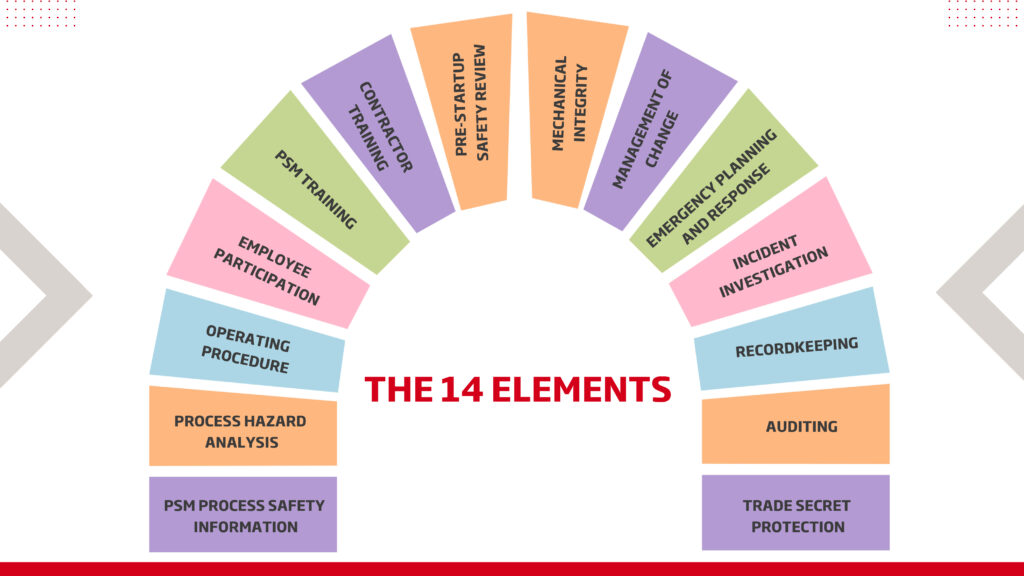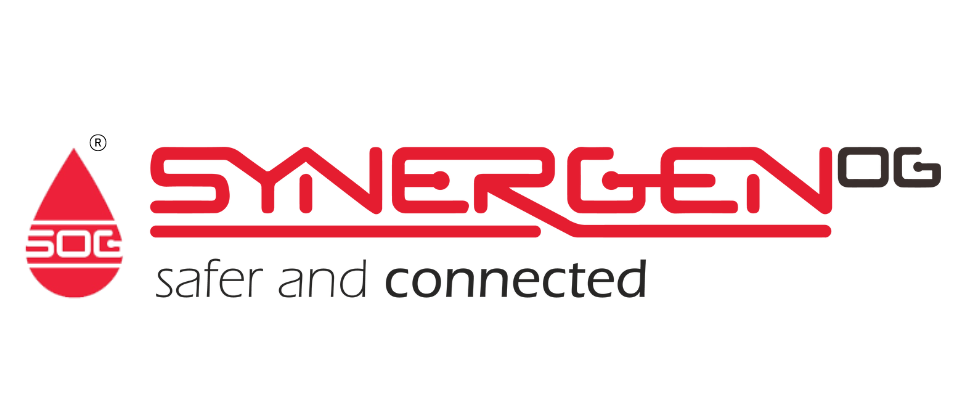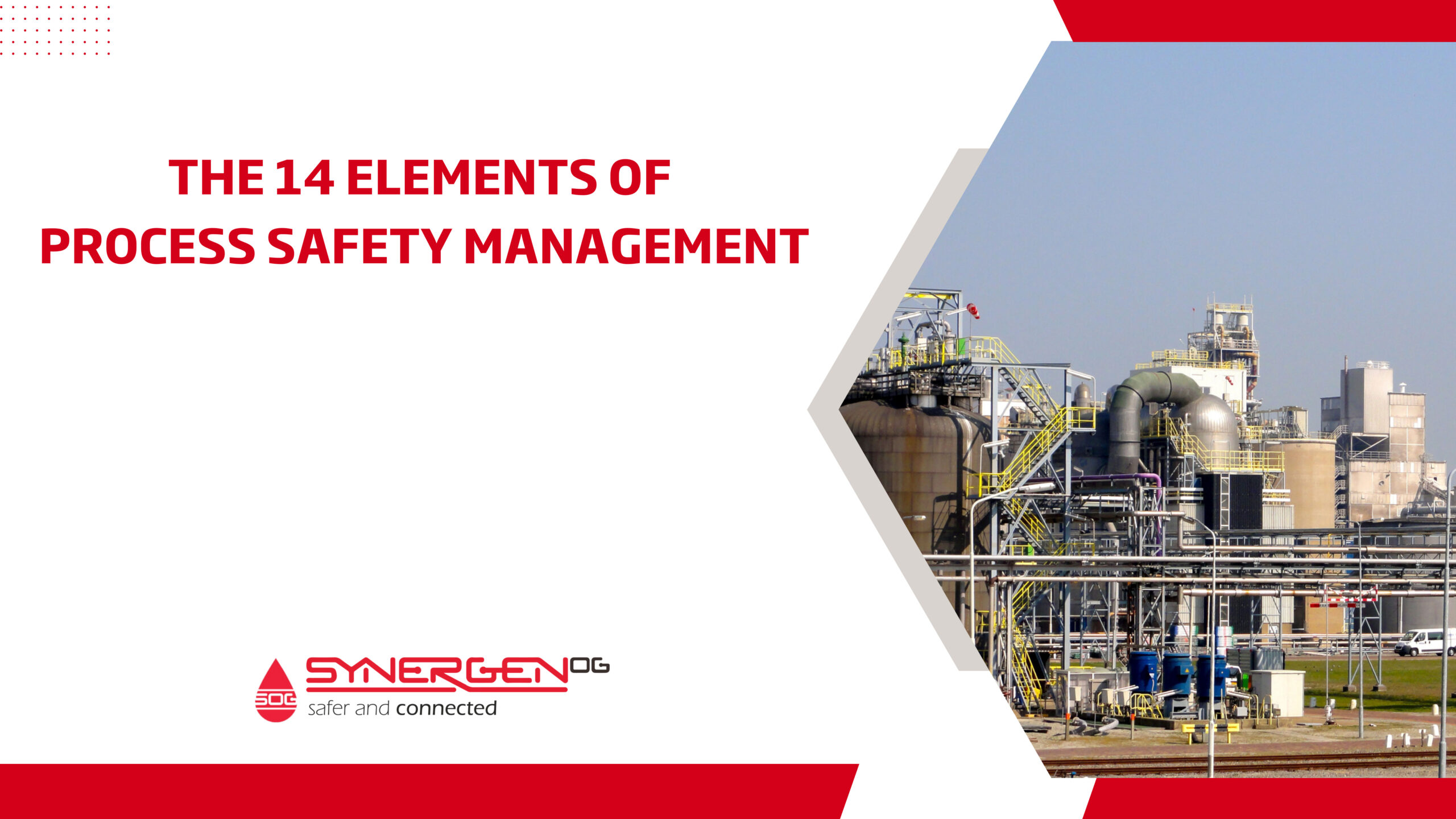So, you’re looking to improve the safety of your process? Great decision. Process safety management is critical for any business, but it can be tough to know where to start.
We’ve put together this handy guide to the 14 elements of PSM. This will give you a good overview of the key areas you need to focus on to keep your process safe and compliant.
The Occupational Safety and Health Administration (OSHA) defines PSM as “a Process safety management (PSM) is a systematic analytical tool for preventing the release of highly hazardous chemicals.” OSHA’s Process Safety Management Standard requires covered facilities to develop and implement written PSM programs.
What Is PSM Planning?
Before we get into the 14 elements of Process Safety Management, let’s first look at what Process Safety Management Planning is.
PSM Planning is a critical part of any process safety management program. By definition, PSM planning is the “development of processes and procedures to identify, evaluate, and control hazards associated with the release of highly hazardous chemicals.”
It’s based on the idea of “zero incidents”, meaning that every process is analysed and risk assessed to prevent potential accidents or incidents.
PSM programs typically address four key areas:
- Process hazard analysis
- Operating procedures
- Training, and
- Maintenance
Other elements may include
- Mechanical Integrity
- Incident Investigation
- Emergency Response Planning, and
- Management Commitment
Process Safety Management and OSHA
PSM is a comprehensive Occupational Safety and Health Administration (OSHA) regulation that requires companies to manage the hazards associated with their chemical processes.
It’s designed to prevent accidents and covers everything from process safety policy and hazard identification to managing change and incident investigation. Any company that handles flammable, toxic, or reactive chemicals is required to implement a PSM program.
So if you’re in the process safety business, you need to be familiar with OSHA’s PSM elements. And if you’re not, then SynergenOG can help. We’re experts in Process Safety Management, and we can help you develop a program that meets OSHA’s stringent requirements.
What Are The 14 Elements of PSM?

1) PSM Process Safety Information
This element requires developing and maintaining process safety information (PSI) for each covered process. The PSI must include information on the hazards associated with the process, as well as the equipment, materials, and personnel involved in the process.
2) Process Hazard Analysis
A hazard analysis must be performed for each covered process to identify potential hazards and develop controls to mitigate those hazards.
The process:
- The PHA process begins with a review of the process and identification of potential hazards.
- The team then evaluates the risks associated with those hazards and develops controls to mitigate those risks.
- Once the PHA is complete, the results are reviewed and approval is obtained from management.
- The approved PHA becomes the basis for developing the process safety management program.
3) Operating Procedures
Operating procedures must be developed for each covered process and must be followed by all personnel involved in the process. The procedures must address all aspects of the process, including start-up, shut-down, emergency response, and normal operation.
4) Employee Participation
Employees must be involved in all aspects of the PSM program, from hazard identification and analysis to developing operating procedures and training. Employees should also be encouraged to report any unsafe conditions or practices they observe.
5) PSM Training
All personnel involved in a covered process must receive training on the key elements of the Process Safety Management program relevant to their job duties. The training must be specific to the process and cover topics such as hazard identification and control, operating procedures, emergency response, etc.
6) Contractor Training
Contractors who work on or around covered processes must receive training on the elements of the PSM program relevant to their job duties.
The training must be specific to the contractor’s scope of work and cover topics such as hazard identification and control, operating procedures, emergency response, etc.
7) Pre-startup Review
A pre-startup review (PSR) must be conducted for all new or modified processes before start-up. The PSR must ensure that all process hazards have been identified and controls implemented to mitigate those hazards.
8) Mechanical Integrity
Equipment used in covered processes must be maintained safely and reasonably. A mechanical integrity program must be established to ensure that equipment is properly inspected, tested, and repaired/replaced as needed.
9) Management of Change
Any changes made to a covered process must be carefully planned and implemented to prevent any adverse impacts on process safety. Management of change (MOC) procedure must be followed to ensure all changes are reviewed and approved before implementation.
10) Emergency Planning and Response
An emergency response plan (ERP) must be developed for each covered process. The ERP must identify the potential emergencies that could occur and detail the steps that should be taken to respond to those emergencies. All personnel involved in the process must be trained on the ERP.
11) Incident Investigation
All incidents in covered processes must be investigated to determine the root cause(s) and to develop corrective actions to prevent future incidents.
A thorough incident investigation will include interviews with witnesses, a review of physical evidence, and an analysis of any relevant data (such as safety data sheets or maintenance records).
12) Recordkeeping
Records must be kept for all aspects of the PSM program, including process safety information, hazard analyses, operating procedures, training records, etc.
Good record-keeping is essential for two reasons: first, it helps you stay compliant with the law; and second, it helps you track the status of your hazardous materials.
13) Auditing
The PSM program must be audited regularly by qualified personnel to ensure that it is implemented effectively and complies with regulatory requirements. The audit scope should cover all aspects of the PSM system, from managerial oversight to operational procedures.
14) Trade Secret Protection
Process safety information considered a trade secret must be protected from disclosure to unauthorised personnel. There are a number of ways to protect trade secrets, including physical security measures, electronic security measures, and non-disclosure agreements.
- Physical security measures involve keeping the information in a secure location where only authorised individuals have access.
- Electronic security measures include storing the information on a password-protected computer or server, and backing up the data in a secure location.
- Non-disclosure agreements are contracts between the company and employees, contractors, or other parties that prohibit the unauthorised disclosure of trade secrets.
How to Implement Process Safety Management
When it comes to implementing Process Safety Management, there are a few key steps you need to take to get started.
Step 1: You need to develop a system that’s tailored to your specific business. This system should include all the steps you need to take to keep your employees safe, your customers, and the environment.
Step 2: Make sure everyone in your organization is on board. This means getting buy-in from your managers and making sure your employees are familiar with the system and know how to use it.
Step 3: Put in place a process for continuous improvement. No system is perfect, so you need to be constantly looking for ways to make it better.
If you follow these steps, you’ll be well on implementing a successful Process Safety Management system.
Why do We Need Process Safety Management
Process safety management is a process-oriented approach to ensuring that workers are protected from the potential hazards posed by their processes.
It is a comprehensive approach to managing all aspects of a process, including
- The identification and assessment of risks to health, safety, and the environment
- The establishment of safe work practices
- The development and review of procedures and standard operating instructions (SOPs)
- The training of personnel responsible for implementing the SOPs
- The review of SOPs and procedures regularly to ensure they are working effectively
This is why Process Safety Management is so important. By implementing a system that covers all the bases, we can avoid disasters.
The Benefits of Implementing Process Safety Management
There are many benefits of implementing a PSM program, including:
- Reduced risk of major accidents: By identifying and addressing potential hazards, PSM can help prevent major accidents from occurring.
- Improved employee safety: PSM programs help ensure that employees are properly trained and aware of potential hazards. This can lead to fewer workplace injuries and fatalities.
- Reduced liability exposure: Properly implemented PSM programs can help reduce a company’s liability exposure in the event of an accident.
- Enhanced public image: A commitment to safety can improve a company’s public image and reputation.
Ensuring Process Safety Through Training
Process safety training is essential to ensure that employees are aware of the potential risks involved in their work and know how to mitigate those risks.
When designing a process safety training program, there are a few key elements to consider:
- The hazards involved in the process
- The consequences of an incident
- The control measures that are in place to mitigate the risks posed by the hazard. The emergency response procedures that should be followed in the event of an incident
- The roles and responsibilities of each employee in relation to process safety
- The importance of following procedures and maintaining good communication between all members of the team
Review and Audit Your PSM Program
An effective PSM program is vital to the safe operation of any industrial facility. PSM programs help to identify and control potential hazards that could lead to the release of hazardous materials. Reviewing and auditing your PSM program on a regular basis can help ensure that it is effective and up-to-date.
When conducting a review or audit of your PSM program, there are a few key elements to keep in mind:
1) Program Effectiveness – Is the program actually achieving its goals? Are potential hazards being identified and controlled effectively?
2) Program Documentation – Is the program well documented? Are procedures, training records, etc., up-to-date and easily accessible?
3) Program Implementation – Is the program being implemented correctly? Are employees appropriately trained and following procedures?
4) Program Monitoring – Is the program being monitored regularly? Are audits conducted regularly to ensure compliance?
5) Corrective Actions – When problems are identified, are corrective actions taken promptly?
By keeping these elements in mind, you can ensure that your PSM program is effective and compliant with regulations.
Bottomline
PSM is a critical system in any organization, and all 14 elements of PSM must be carefully managed to ensure the safety of employees, contractors, and the public. While some elements may take more time and resources to implement, each one is essential to the success of PSM.
FAQ - 14 Elements of PSM
- What is PSM Planning?
PSM planning is the process of creating a plan for implementing and maintaining Process Safety Management. This plan will include goal setting, organizational roles and responsibilities, and safety procedures.
- What is included in Process Safety Information?
Process safety information includes everything from hazard identification and risk assessment to operating procedures and emergency response plans. It’s a comprehensive guide to keeping your workers safe and preventing accidents.
- What is Process Safety Fundamentals?
Process safety fundamentals are guidelines that emphasize good practices that would help prevent the occurrence of a major accident. These guidelines are applicable to everyone working with hazardous materials from management to the workforce.
- What is Process Safety Study?
Process safety study is a thorough assessment that identifies potential causes and evaluates the consequences of hazardous releases, e.g., bowtie analysis, HAZOP, HAZID, FSAs etc.
- What does Process Safety Management (PSM) mean in safety?
Process Safety Management addresses the safety measures required to prevent accidental release of hazardous material from its containment such as vessel, piping and tank. Process Safety Management is a structured and proactive risk-based approach which uses implementation techniques to manage process safety risks.
- What are the basic principles of safety management?
The basic principles of effective safety management are Planning, Doing, Checking, and Acting (PDCA).
- What are the importance of safety management?
Safety management is important to prevent accidents, injuries and ensure a safe business operation through applying suitable principles, frameworks and processes.
- What is the importance of process safety?
Process safety is important to prevent catastrophic events/ major accident hazards, serious injuries and illnesses, property damage, lost production, and negative environmental impact.and help reduce the occurence of a major accident.


[…] Learn More: https://synergenog.com/14-elements-psm/ […]
[…] OSHA standards mandate a PHA for any industrial process that involves hazardous chemicals that Hazardous chemical releases pose a significant risk to the environment and human communities close to manufacturing plants. In addition, such releases will have major implications for the offending company. This means hefty fines and other legal liabilities. […]
[…] Process And Operation Safety Management, starting with Process Safety Management, emphasising the 14 elements of PSM, followed by Effective Risk Management (ERM) and Barrier-based Risk Management […]
[…] PSM is not simply a regulatory requirement, it’s a business-critical strategy. By preventing chemical releases and process failures, PSM safeguards workers, communities, the environment, and business assets. From design to decommissioning, process safety must be embedded at every stage of an operation. […]